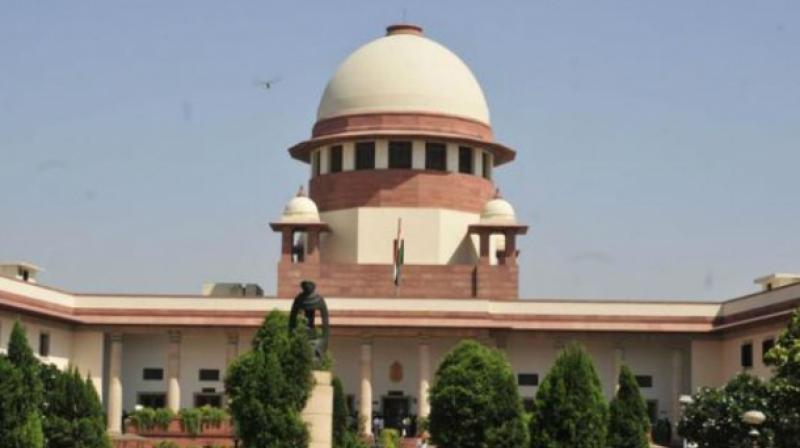Will basic structure' be nation's saviour?
To get over the bar of the Kesvananda Bharti judgment, the 42nd Amendment was enacted into law by Parliament in 1976.

Earlier this week was the 44th anniversary of the most seminal event in Indian jurisprudence. On April 24, 1973, the “basic structure doctrine” of the Indian Constitution was midwifed into life by the largest-ever bench of the Supreme Court of India to be constituted till date.
A doctrine conceptualised by the Supreme Court to restrain the constituent powers of Parliament, with regard to which articles of the Constitution the supreme legislative body in India could amend and which were beyond the scope of its ability to amend, delete or add.
A bench of 13 judges of the Supreme Court by a majority of seven judges to six, decided that the Constitution could not be amended in a manner that distorted its basic structure. Intriguingly, 12 of the 13 judges didn’t say a word about the “basic structure”, in their pronouncements. While six ruled that there were implied limitations on the amending power of Article 368 of the Constitution, and the other six held that the power was unlimited. The law of the basic structure came from the pen of one judge, Hans Raj Khanna, and which was adopted by the court through a judicial order entitled the “View of the Majority”, a document in the form of a order of the court signed only by nine judges out of 13 on the bench.
An unfortunate fallout of the judgment was the supersession of Justices Amar Nath Grover, Jayanti Manilal Shelat and Kawdoor Sadananda Hegde because they had batted on the side of the basic structure. A.N. Ray, who was fourth in the order of seniority, was made the Chief Justice of India.
The question of the legitimacy of the basic structure doctrine was raised immediately thereafter, and critics refused to recognise the order signed only by nine of the 13 judges to be the law laid down by the court.
By a quirk of fate the doctrine got further legitimacy after the Allahabad high court set aside the election of Prime Minister Indira Gandhi and the then government amended the Constitution to introduce the 39th Amendment, by which the election of the Prime Minister and some other high dignitaries could not be called into question before a court of law.
When the amendment was challenged before the Supreme Court on the ground that it violated the basic structure of the Constitution, the then attorney-general conceded the doctrine. The amendment was struck down on the basis of the basic structure doctrine. Soon thereafter, an aborted attempt was made to review the basic structure doctrine but after two days the review bench, again of 13 judges, was dissolved abruptly, never to reconvene. Thus, the basic structure doctrine got consecrated as the holy grail of jurisprudence.
One can only wonder what would have happened if the attorney-general had not conceded the doctrine, but challenged its very existence during the 39th Amendment to the Constitution, specially since the entire court at that point had only one judge who had subscribed to the doctrine, namely Justice Khanna.
To get over the bar of the Kesvananda Bharti judgment, the 42nd Amendment was enacted into law by Parliament in 1976. It added to the amending power of Article 368 of the Constitution Clause 5, which read “For the removal of doubts, it is hereby declared that there shall be no limitation whatever on the constituent power of Parliament to amend by way of addition, variation or repeal the provisions of the Constitution under this article.” Evidently, the language employed by the draftsman of this clause had a single agenda — to declare that the power of Parliament to amend the Constitution was unlimited and unfettered.
Since its discovery by Justice Khanna’s pen, the “basic structure” doctrine has been employed five times to strike constitutional amendments down — the 39th Amendment tailored to insulate the Prime Minister’s and other high constitutional dignitaries election from legal challenge, the refusal to the vital right of judicial review in the cases of Minerva Mills, Kihoto Hollohon and L. Chandra Kumar. More recently, the court struck down what is popularly referred to as the National Judicial Commission Amendment because it fell foul of the independence of the judiciary, a basic feature of the Constitution.
What started as a struggle between the court and the government on property rights expanded into a battle for the soul of the Constitution. It became a confrontation between the judiciary and the legislature that the Constitution not be so altered that it loses its fundamental identity.
The Kesvananda Bharti case happened at a point in time when many of the eminences in the current Central government were apprehensive of India becoming a one-party state — a fear that turned out to be unfounded. However, in a reversal of fortune the spectre of totalitarianism, fear of intolerance and India morphing into a one-party state hangs low over this country from the very ones for whom Kesvananda Bharti had come as a sigh of relief in 1973.
As institutions are openly being subverted from within and without, as fundamental freedoms of thought, expression, worship are sought to be bludgeoned into conformity, as culinary choices are now the staple of lynching, mobocracy and vigilantism, as substantial sections of the so-called free media are behaving like pet performing poodles of the rulers and as even the legitimacy of democratic outcomes is the subject matter of substantive skepticism, if not outright derision, one cannot help but salute those nine wise men specially Chief Justice Sikri, who devised the instrument of the order of the majority and breathed life into a Constitutional fiat called basic structure. Should we say — may God bless them? It may just be the only safeguard left to protect, preserve and uphold the founding vision of India if the Opposition does a humpty-dumpty on the nation.

